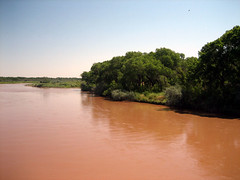My first visit to Albuquerque, at least the first that I remember, was some time in the mid-1970s. I was a teenager, and we stayed with friends in Dietz Farm, in a house in the shade of the cottonwoods that backed up on the ditch along the east side of the Rio Grande.
I remember towering afternoon thunderstorms. We didn’t get wet every day, but a day did not go by that you couldn’t see them somewhere nearby. I’ve been remembering that visit this week, as the rains make a valiant attempt at returning.
We’ve had rain in parts of New Mexico every day for the last week or so, spotty thunderstorms that have an awfully monsoonal look. The forecasters have been suggesting it’s not quite monsoonal yet, and I haven’t been doing of my own journalistic due diligence, so I’ve no ammunition with which to disagree. But whatever it is, it’s been lovely.
Yesterday morning I rode my bike up to the Alameda Bridge at the north end of town, and the river was running a beautiful muddy red. The river’s been quite low, but if you click through to the link you’ll see how it popped up every time it rained over the last week.
Those not from here may puzzle over or word – “monsoon” – to describe them. This is not the same sort of dramatic phenomenon that they have in Asia, but it has enough of the same characteristics that the climate geeks are comfortable with the word. The basic mechanism involves heating of the raised land surface of the Colorado Plateau, which triggers – typically some time in early July around where I live – a flow of moisture that provides the fuel.
Once it’s here, thermals take care of the rest, providing the lift to get the moisture up where it can do some good.
I could see it happening on my ride yesterday, rising towers of cloud up over the Jemez Mountains to the north and, later, over the Sandias. To really get things going, the dewpoints need to be reasonably high – around 50F (10C) or higher. We’ve been hovering around there all week. As I write, it’s 47F (~8C) at the National Weather Service station out at the airport, and an unofficial 48F (9C) at my house.
One of the difficulties in knowing whether this is “the monsoon” is the lack of a formal definition here. In Tucson, the National Weather Service defines it as three consecutive days with the daily average dewpoint over 54F (~12C). (And for good measure, they then backdate their records, so the actual start of the monsoon is the first of those three days.) They’ve been getting rain for a week, and it looks like they’ll meet formal criterion today, which would mean an official monsoon start of June 30 for them, four days early.
My obsession with this, rooted in that visit to Albuquerque three decades ago, might seem strange. Let me try to explain. First, it’s a fascinating meteorological/climatological phenomenon that appeals to the weather geek in me. But more importantly, there’s this psychic joy in a coming thunderstorm. Here’s how I put it in a newspaper story a couple of weeks ago:
(M)eteorology can’t explain the psychic relief of the smell that accompanies those first big drops that herald a New Mexico summer thunderstorm— the crack of thunder breaking the back of summer’s dusty heat.
This spring and summer’s heat has been particularly dusty, so the eagerness with which I’ve been watching dewpoints and precipitation maps has been especially acute.


Well, there were over 25.4 cm (10″) of rain in the Washington, DC area last week. Monday’s inundation was as close to a tropical rainstorm (Panama, Brazil, etc.) as I have ever seen in the US. This got us back to and above normal for the summer, but all in one go after a fairly dry year.
There’s a word for the smell: Petrichor.